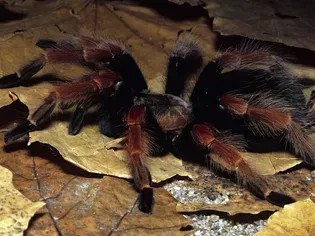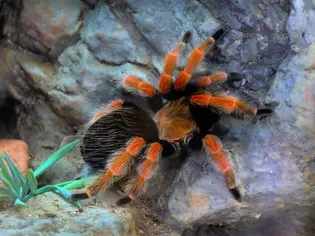How to Care for a Pet Mexican Redleg Tarantula
Updated on 05/26/24

Unveiling the Enigmatic World of the Mexican Redleg Tarantula: A Comprehensive Guide to Care and Captivity
Embark on an extraordinary journey into the captivating realm of the Mexican Redleg Tarantula (Brachypelma hamorii), a captivating species renowned for its striking coloration and fascinating behaviors. As you delve into this comprehensive guide, we will unravel the secrets of caring for these enigmatic creatures, ensuring their well-being and unlocking their hidden beauty.
Chapter 1: Laying the Foundation for a Thriving Habitat
* Enclosure Requirements: Provide an appropriately sized enclosure, typically around 10-15 gallons, with adequate ventilation and a secure lid to prevent escape.
* Substrate Selection: Choose a substrate that mimics the tarantula's natural habitat, such as coco fiber, peat moss, or a mixture of the two, to allow for burrowing.
* Temperature and Humidity Control: Maintain optimal temperature and humidity levels using a thermostat and hygrometer. Aim for temperatures between 75-80°F (24-27°C) and humidity levels around 70-80%.
* Decor and Hiding Places: Provide hiding spots such as cork bark, rocks, or live plants to create a natural and secure environment.
Chapter 2: Nutrition and Hydration
* Dietary Requirements: Feed adult tarantulas a variety of live insects such as crickets, dubia roaches, or mealworms. Offer prey items that are no larger than the tarantula's carapace to prevent injury.
* Water Provision: Place a shallow water dish in the enclosure to provide constant hydration. Ensure the dish is shallow enough to prevent drowning and is kept clean to avoid contamination.
* Feeding Frequency: Adult tarantulas typically eat once or twice a week, while juveniles may need to be fed more frequently. Monitor their eating habits and adjust feeding schedules accordingly.
Chapter 3: Health and Veterinary Care
* Molting Process: Tarantulas shed their exoskeletons as they grow, a process known as molting. Provide ample space and privacy during this vulnerable time.
* Potential Ailments: Be aware of common ailments such as dehydration, parasites, and impaction. Seek professional veterinary care if any unusual symptoms or health concerns arise.
* Venom Management: While not considered medically significant to humans, the Mexican Redleg Tarantula's venom can cause localized pain and irritation. Handle with care and use caution when handling molted exoskeletons.
Chapter 4: Behavioral Insights
* Territorial Behavior: Mexican Redleg Tarantulas are typically solitary creatures and may become aggressive if their territory is threatened. Avoid handling them excessively or placing multiple tarantulas in the same enclosure.
* Nocturnal Nature: These tarantulas are primarily nocturnal, so observe their behaviors during the night or evening hours.
* Defensive Techniques: When threatened, tarantulas can release urticating hairs from their abdomen or adopt a defensive posture. Respect their boundaries and avoid unnecessary handling.
Chapter 5: Enrichment and Stimulation
* Environmental Enrichment: Provide a variety of hiding places, climbing structures, and live plants to stimulate their natural behaviors.
* Sensory Stimulation: Offer food items of various sizes, textures, and shapes to keep them engaged and active.
* Avoid Overhandling: While handling can be beneficial for health checks, keep it to a minimum to avoid stress and potential injuries.
Chapter 6: Ethical Considerations
* Responsible Ownership: Ensure you have the necessary knowledge, facilities, and financial resources to provide proper care before acquiring a Mexican Redleg Tarantula.
* Captive Breeding: Support reputable breeders and captive breeding programs that promote the conservation and genetic diversity of the species.
* Respect for Wildlife: Never collect wild tarantulas for captive purposes. They play vital roles in their ecosystems, and their removal can have detrimental effects.
Conclusion
Embracing the Mexican Redleg Tarantula into your life is not merely about owning a pet; it's about delving into a fascinating world of biodiversity and unlocking the mysteries of these captivating creatures. By following the comprehensive guidelines outlined in this guide, you can ensure their well-being, marvel at their unique behaviors, and foster a deep appreciation for the enigmatic realm of tarantulas.
Explore More Pets

Exotic Pet Species
Should You Keep a Chimpanzee as a Pet?

Exotic Pet Species
Should You Keep a Raccoon as a Pet?

Exotic Pet Species
How to Care for a Pet Mexican Red-Knee Tarantula

Exotic Pet Species
12 Best Exotic Pets for Apartment Living

Exotic Pet Species
Best Foxes to Keep as Pets

Exotic Pet Species
Should You Keep a Northern Flying Squirrel as a Pet?

Exotic Pet Species
Should You Keep Stick Insect as a Pet?

Exotic Pet Species
Should You Keep a Big Cat as a Pet?
